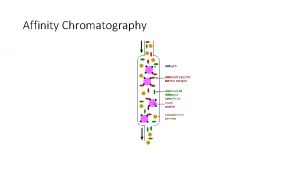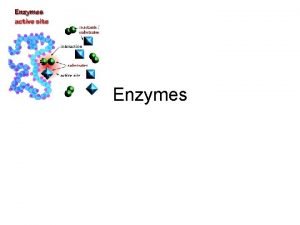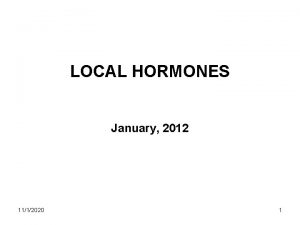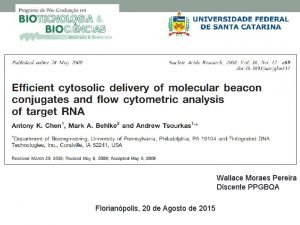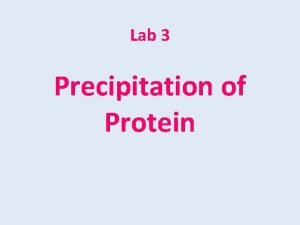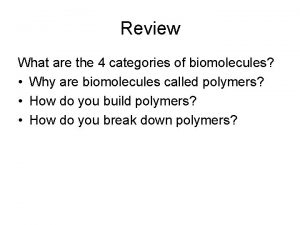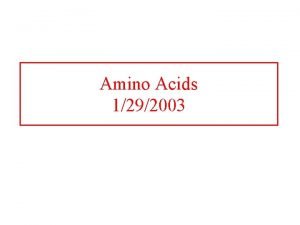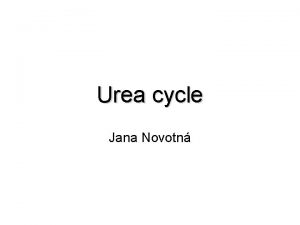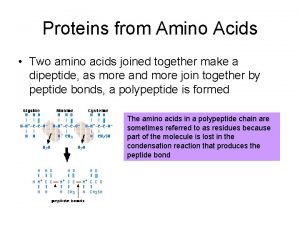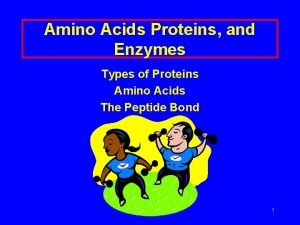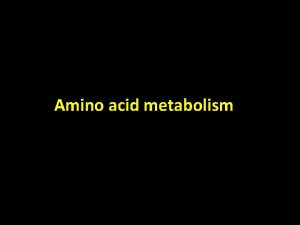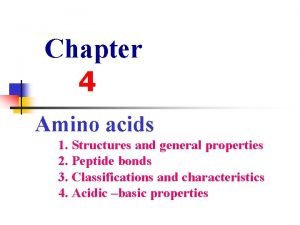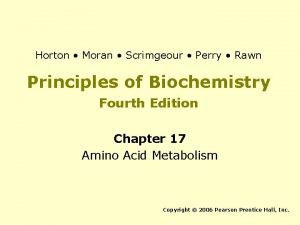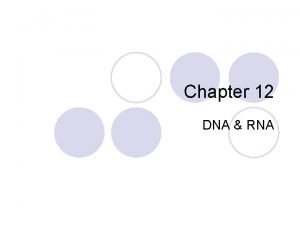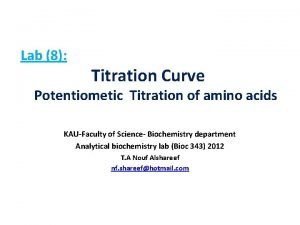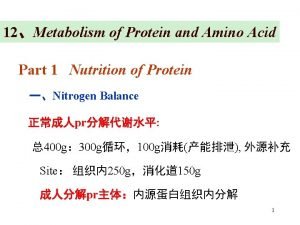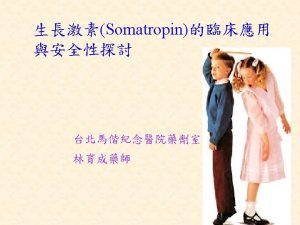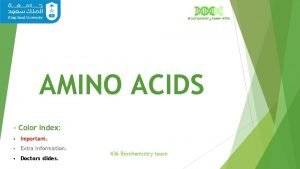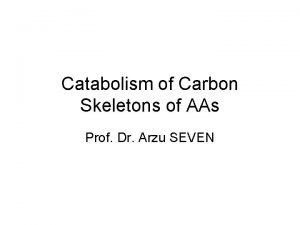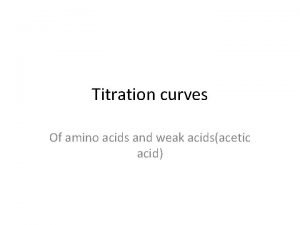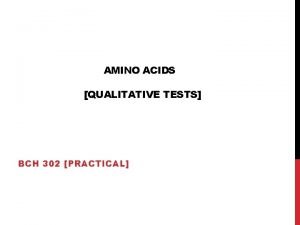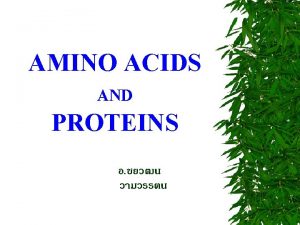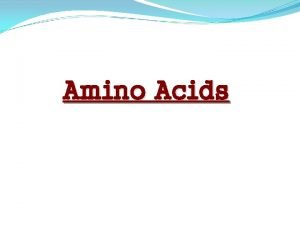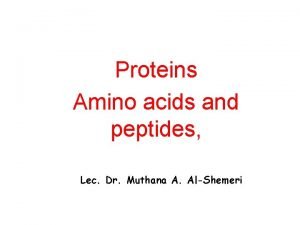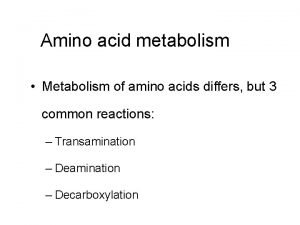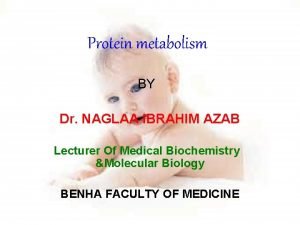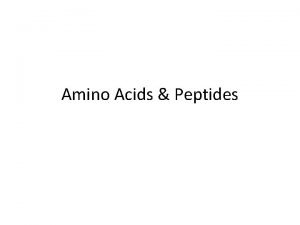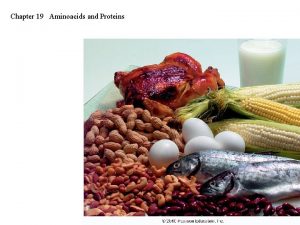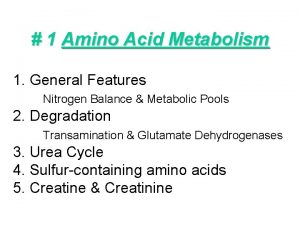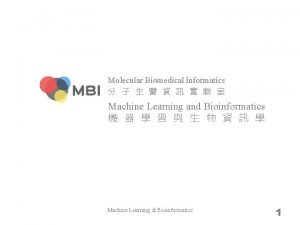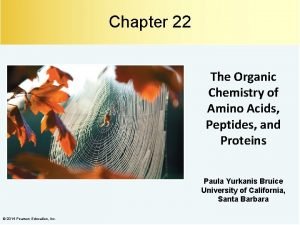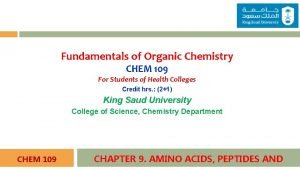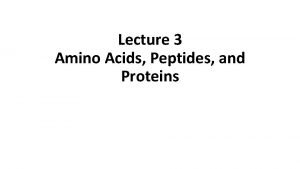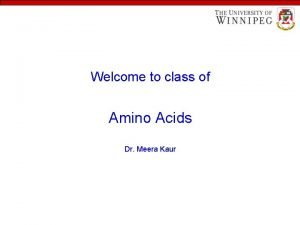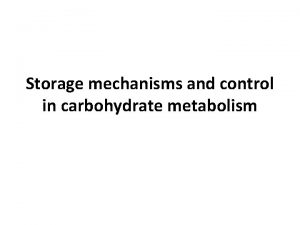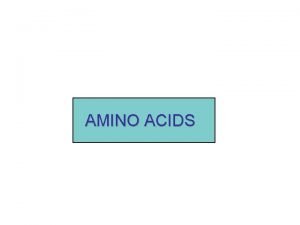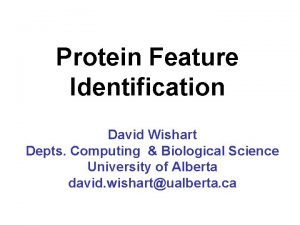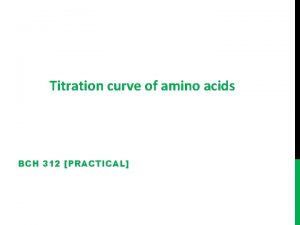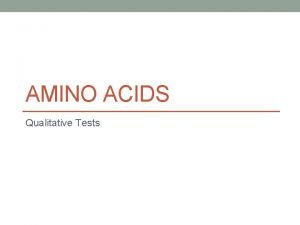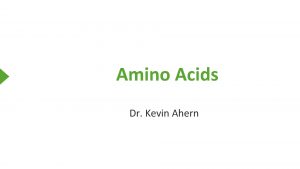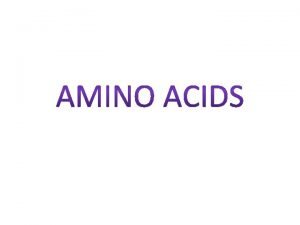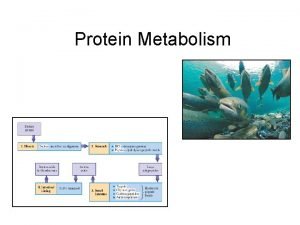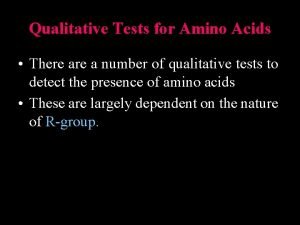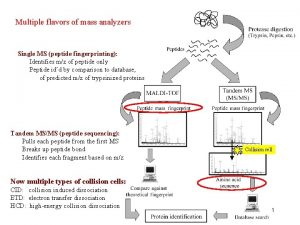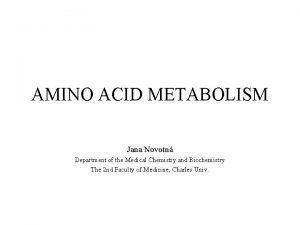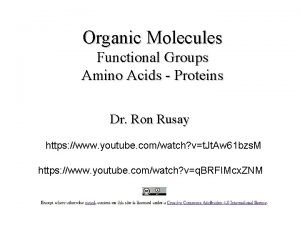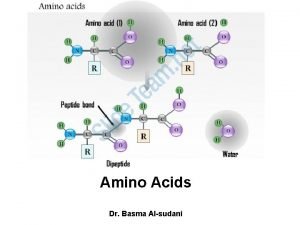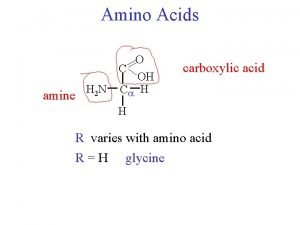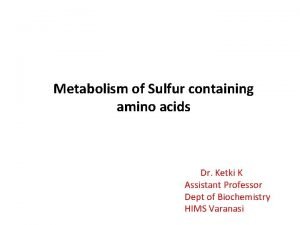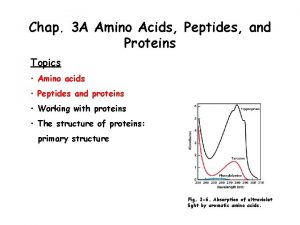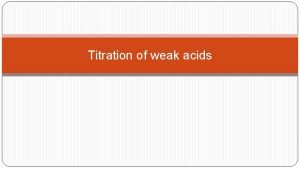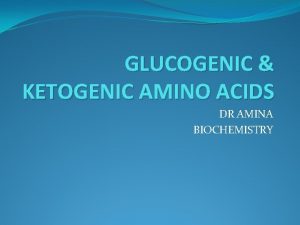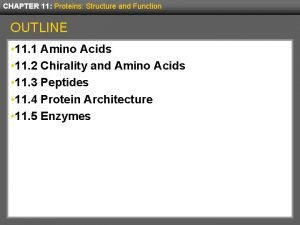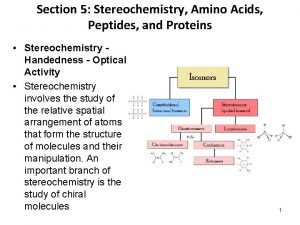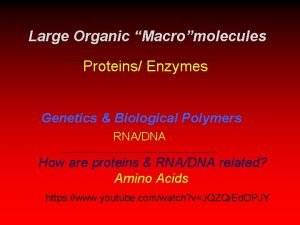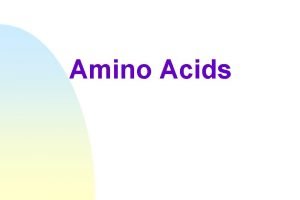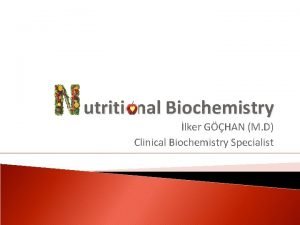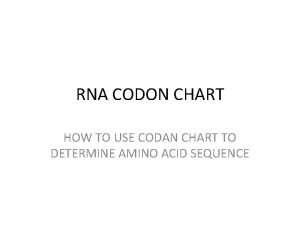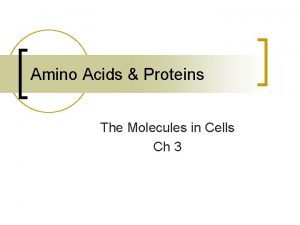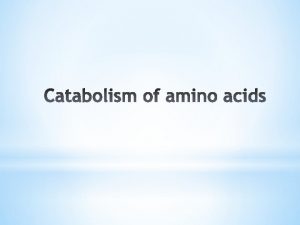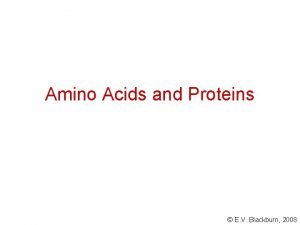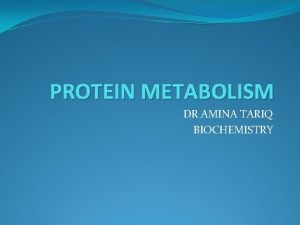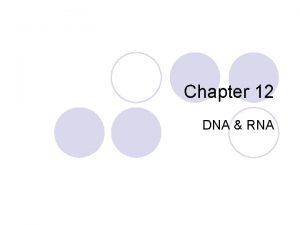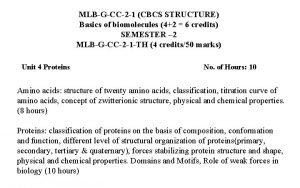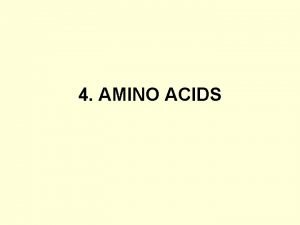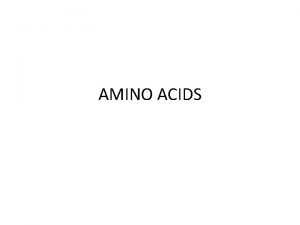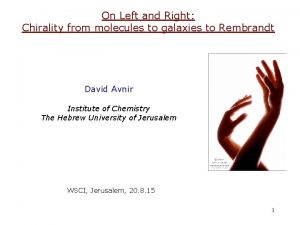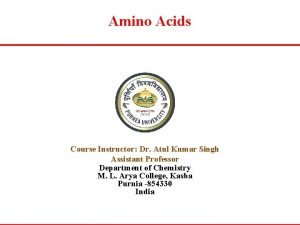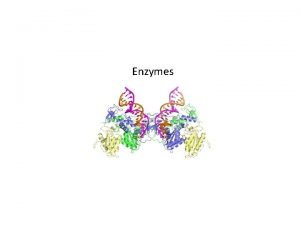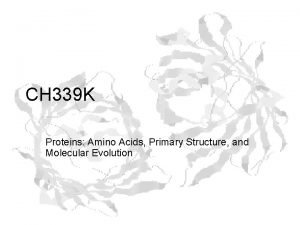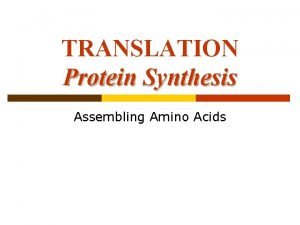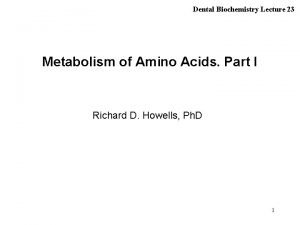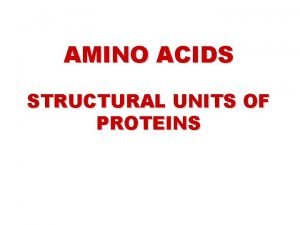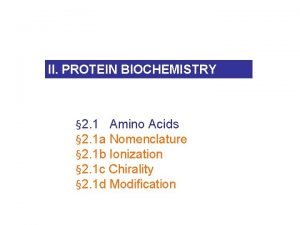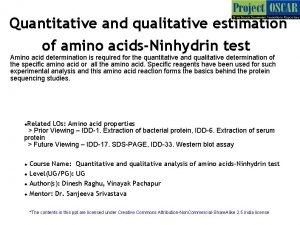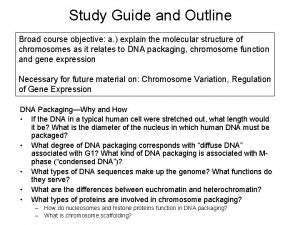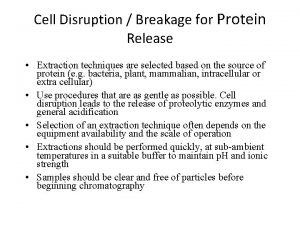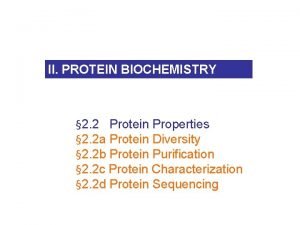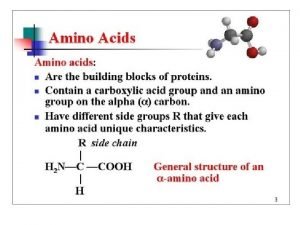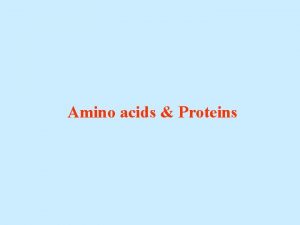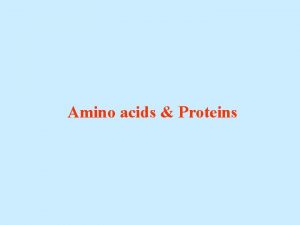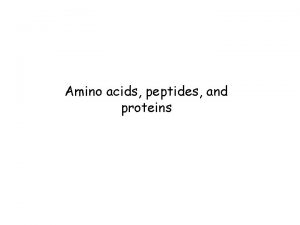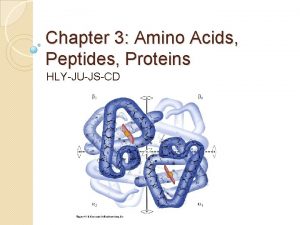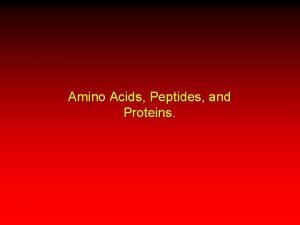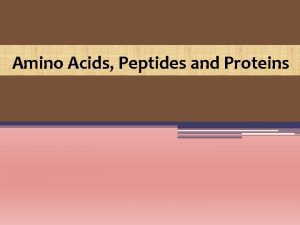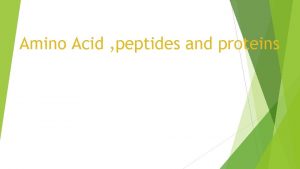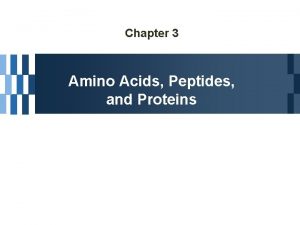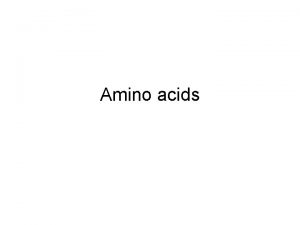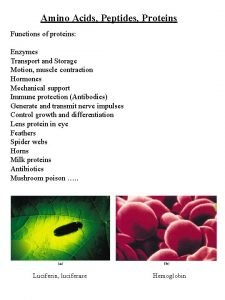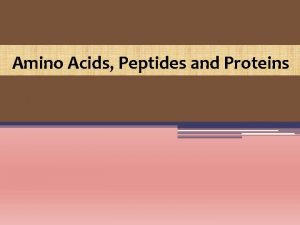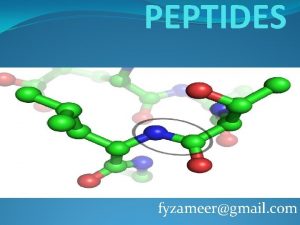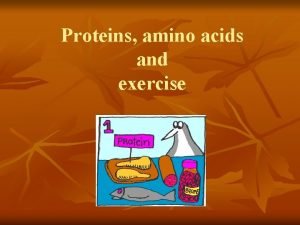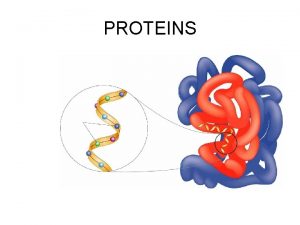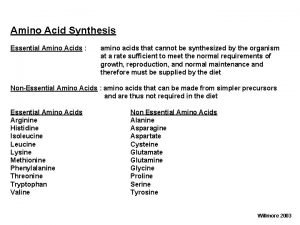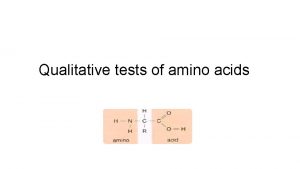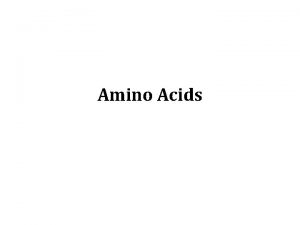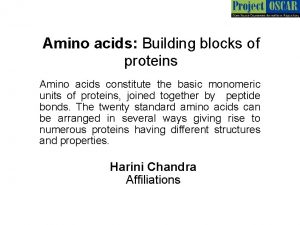Amino Acids Peptides Proteins Amino Acids Zwitterion or



























































































- Slides: 91

Amino Acids, Peptides & Proteins Amino Acids Zwitterion or ampholyte Peptides Proteins Structure of Proteins Separation & purification Protein Sequencing Protein Synthesis


Our Life Is Maintained by Molecular Network Systems Molecular network system in a cell

Proteins Play Key Roles in a Living System • Three examples of protein functions Alcohol dehydrogenase oxidizes alcohols to aldehydes or ketones – Catalysis: Almost all chemical reactions in a living cell are catalyzed by protein enzymes. – Transport: Some proteins transports various substances, such as oxygen, ions, and so on. – Information transfer: For example, hormones. Haemoglobin carries oxygen Insulin controls the amount of sugar in the blood

Estimated Functional Roles (by % of Proteins) of the Proteome in a Complex Organism

Protein Functions • Transport • Regulatory • Motor • Fibrous Protein • Enzyme • Immunoglobulin



20 Amino acids Glycine (G) Alanine (A) Valine (V) Isoleucine (I) Leucine (L) Proline (P) Methionine (M) Phenylalanine (F) Tryptophan (W) Asparagine (N) Glutamine (Q) Serine (S) Threonine (T) Tyrosine (Y) Cysteine (C) Asparatic acid (D) Glutamic acid (E) Lysine (K) Arginine (R) Histidine (H) White: Hydrophobic, Green: Hydrophilic, Red: Acidic, Blue: Basic

a-amino aicds All proteins are composed of amino acids Ø Twenty common amino acids Ø All amino acids are primary amino acids except for proline Ø A primary amino group is attached to the a-carbon of carboxyl group Ø Except for Glycine, all other amino acids have at least one chiral centers Ø All chiral amino acids are belong to L-amino acids Ø


Amino acids vary in Size Structure Electric charge Solubility in water

Classification of amino acids Classified by polarity of side chains hydrophobic: water fearing, non-polar side chains hydrophilic: water loving, polar neutral positively charged negatively charged aromatic












Titration curve of amino acids Neutral side chain Acidic side chain Basic side chain









Peptide Bond

Peptides Dipeptide Tripeptide Tetrapeptide Oligopeptide Polypeptide Protein

Peptide Bond

Replace -ine by -yl but keep the last -ine ! Ala-Gly-Arg Alanylglycylarginine

Structure of Proteins Primary structure Secondary structure Tertiary structure Quaternary structure





Peptide & Protein Charge p. I = ?

Group p. Ka p. H=1 p. H=3 p. H=7 -COOH 2. 2 0 - - -NH 2 8. 8 + + + 0 0 0 Glu 4. 3 0 0 - - Lys 10. 8 + + 0 0 Arg 12. 5 + + + 0 +3 +2 +1 0 -1 -2 Net Charge p. H=10 p. H=11 p. H=13 p. I = (8. 8 + 10. 8)/2 = 9. 8

Protein Separation/Purification • In general, proteins contain > 40 residues – Minimum needed to fold into tertiary structure • Usually 100 -1000 residues; percent of each AA varies • Proteins separated based on differences in size and composition • Proteins must be pure to analyze, determine structure/function • Factors to control (to avoid denaturation or chemical degradation) – – – p. H Presence of enzymes Temperature Reactive thiol groups Exposure to air, water

Methods of Separation/Purification • Solubility (salts, solvents, p. H, temperature) • Chromatography – Ion exchange – Gel filtration – Affinity • Electrophoresis















Protein Sequencing Traditional Chemical Method (Sanger Method) Genetic Method Proteomics


A Common Strategy for Protein Sequencing

Hydrolysis • A polypeptide can be hydrolyzed by refluxing with 6 M hydrochloric acid for 24 h • The individual amino acids can be separated from each other using a cation-exchange resin – An acidic solution of the amino acids is passed through the cationexchange column; the strength of adsorption varies with the basicity of each amino acid (the most basic are held most strongly) – Washing the column with a sequence of buffered solutions causes the amino acids to move through it at different rates

• In the original method, the column eluant is treated with ninhydrin, a dye used for detecting and quantifying each amino acid as it comes off the column • In modern practice, analysis of amino acid mixtures is routinely accomplished using high performance liquid 64 chromatography (HPLC)

– Sanger N-Terminal Analysis • The N-terminal end of the polypeptide is labeled with 2, 4 -dinitrofluorobenzene and the polypeptide is hydrolyzed – The labeled N-terminal amino acid is separated from the mixture and identified • The Sanger method is not as widely used as the Edman method


– C-Terminal Analysis • Enzymes called carboxypeptidases hydrolyze C-terminal amino acids selectively – The enzyme continues to release each newly exposed C-terminal amino acid as the peptide is hydrolyzed; it is necessary to monitor the release of C-terminal amino acids as a function of time to identify them

• Primary Structure of Polypeptides and Proteins • The sequence of amino acids in a polypeptide is called its primary structure – Several methods exist to elucidate the primary structure of peptides – Edman Degradation • Edman degradation involve sequential cleavage and identification of N-terminal amino acids • Edman degradation works well for polypeptide sequence analyses up to approximately 60 amino acid residues – The N-terminal residue of the polypeptide reacts with phenyl isothiocyanate – The resulting phenylthiocarbamyl derivative is cleaved from the peptide chain 68

– The unstable product rearranges to a stable phenylthiohydantoin (PTH) which is purified by HPLC and identified by comparison with PTH standards • Automated amino acid sequencing machines use the Edman degradation and high performance liquid chromatography (HPLC) – One Edman degradation cycle beginning with a picomolar amount of polypeptide can be completed in approximately 30 minutes – Each cycle results in identification of the next amino acid residue in the peptide


– Complete Sequence Analysis • The Sanger and Edman methods of analysis apply to short polypeptide sequences (up to about 60 amino acid residues by Edman degradation) • For large proteins and polypeptides, the sample is subjected to partial hydrolysis with dilute acid to give a random assortment of shorter polypeptides which are then analyzed – The smaller polypeptides are sequenced, and regions of overlap among them allow the entire polypeptide to be sequenced

• Larger polypeptides can also be cleaved into smaller sequences using site-specific reagents and enzymes – The use of these agents gives more predictable fragments which can again be overlapped to obtain the sequence of the entire polypeptide – Cyanogen bromide (CNBr) cleaves peptide bonds only on the C-terminal side of methionine residues Mass spectrometry can be used to determine polypeptide and protein sequences







“Ladder sequencing” involves analyzing a polypeptide digest by mass spectrometry, wherein each polypeptide in the digest differs by one amino acid in length; the difference in mass between each adjacent peak indicates the amino acid that occupies that position in the sequence Mass spectra of polypeptide fragments from a protein can be compared with databases of known polypeptide sequences, thus leading to an identification of the protein or a part of its sequence by matching





The Blind Men and the Elephant by John Godfrey Saxe American poet John Godfrey Saxe (1816 -1887) based the following poem on a fable which was told in India many years ago. The Blind Men and the Elephant It was six men of Indostan To learning much inclined, Who went to see the Elephant (Though all of them were blind), That each by observation Might satisfy his mind The First approached the Elephant, And happening to fall Against his broad and sturdy side, At once began to bawl: “God bless me! but the Elephant Is very like a wall!” The Second, feeling of the tusk, Cried, “Ho! what have we here So very round and smooth and sharp? To me ’tis mighty clear This wonder of an Elephant Is very like a spear!” The Third approached the animal, And happening to take The squirming trunk within his hands, Thus boldly up and spake: “I see, ” quoth he, “the Elephant Is very like a snake!” The Fourth reached out an eager hand, And felt about the knee. “What most this wondrous beast is like Is mighty plain, ” quoth he; “ ‘Tis clear enough the Elephant Is very like a tree!” The Fifth, who chanced to touch the ear, Said: “E’en the blindest man Can tell what this resembles most; Deny the fact who can This marvel of an Elephant Is very like a fan!? The Sixth no sooner had begun About the beast to grope, Than, seizing on the swinging tail That fell within his scope, “I see, ” quoth he, “the Elephant Is very like a rope!” And so these men of Indostan Disputed loud and long, Each in his own opinion Exceeding stiff and strong, Though each was partly in the right, And all were in the wrong!

A Fan A Rope A Spear A Tree A Snake A Wall





 Difference between affinity and ion exchange chromatography
Difference between affinity and ion exchange chromatography Amidomalonate synthesis mechanism
Amidomalonate synthesis mechanism Amino acids are joined together in proteins by
Amino acids are joined together in proteins by Image
Image Local hormones
Local hormones Cell penetrating peptides
Cell penetrating peptides Precipitation of proteins by strong mineral acids
Precipitation of proteins by strong mineral acids Quaternary structure of protein
Quaternary structure of protein Amino acids are building blocks of
Amino acids are building blocks of Regulation of urea
Regulation of urea 2 amino acids joined together
2 amino acids joined together Properties of amino acids
Properties of amino acids Protein amino acids
Protein amino acids Transdeamination of amino acids
Transdeamination of amino acids What is made of amino acids
What is made of amino acids Properties of amino acids
Properties of amino acids 17/35
17/35 A _________bond joins amino acids together.
A _________bond joins amino acids together. Pi of alanine
Pi of alanine Catabolism of amino acids
Catabolism of amino acids Non essential amino acids mnemonics
Non essential amino acids mnemonics 191 amino acids
191 amino acids Glutamate isoelectric point
Glutamate isoelectric point Importance of sulphur containing amino acids
Importance of sulphur containing amino acids Non essential amino acids mnemonics
Non essential amino acids mnemonics Amino acid titration curves
Amino acid titration curves Phenol containing amino acids
Phenol containing amino acids What is the r group in amino acids
What is the r group in amino acids Upon hydrolysis of fibron which amino acids are produced?
Upon hydrolysis of fibron which amino acids are produced? Abcdrna
Abcdrna Protein structure
Protein structure Amino acid structure
Amino acid structure Transamination
Transamination Transdeamination of amino acids
Transdeamination of amino acids Biomedical importance of amino acids
Biomedical importance of amino acids Protein amino acids
Protein amino acids Nitrogen balance
Nitrogen balance Wikipedia amino acids
Wikipedia amino acids Chymotrypsin cleaves which amino acids
Chymotrypsin cleaves which amino acids Phospoenol pyruvate
Phospoenol pyruvate Sp hybridization
Sp hybridization Peptide synthesis
Peptide synthesis Classification of amino acids
Classification of amino acids Examples of physical function of art
Examples of physical function of art Polar and non polar amino acids
Polar and non polar amino acids Charged amino acids
Charged amino acids Dehydration synthesis of amino acids
Dehydration synthesis of amino acids Titration curve of amino acids
Titration curve of amino acids Millon's test positive result
Millon's test positive result R groups amino acids
R groups amino acids Solubility of amino acids in water
Solubility of amino acids in water Bilirubin bruise
Bilirubin bruise Qualitative tests for amino acids
Qualitative tests for amino acids Mixed amino acids
Mixed amino acids Jana novotn
Jana novotn 20 amino acid structure
20 amino acid structure Are amino acids negatively charged
Are amino acids negatively charged Acid base chemistry of amino acids
Acid base chemistry of amino acids Meister cycle
Meister cycle Conjugated protein
Conjugated protein Asparagine titration curve
Asparagine titration curve Is valine ketogenic or glucogenic
Is valine ketogenic or glucogenic Salt bridges in proteins
Salt bridges in proteins What is protein
What is protein 20 amino acids structures
20 amino acids structures Ketogenic amino acid
Ketogenic amino acid Utritional
Utritional Amino acid of aug
Amino acid of aug Peptide bond dehydration synthesis
Peptide bond dehydration synthesis Chemical services cosmetology
Chemical services cosmetology Aromatic amino acids
Aromatic amino acids Deamination of amino acids
Deamination of amino acids Amino acid name
Amino acid name Www.chemsheets.co.uk
Www.chemsheets.co.uk Transdeamination of amino acids
Transdeamination of amino acids Chapter 12 dna and rna
Chapter 12 dna and rna Non essential amino acids in food
Non essential amino acids in food Properties of amino acids slideshare
Properties of amino acids slideshare Difference between hydrophobic and hydrophilic amino acids
Difference between hydrophobic and hydrophilic amino acids Net charges of amino acids
Net charges of amino acids Early man
Early man Conditionally essential amino acids
Conditionally essential amino acids What is made of amino acids
What is made of amino acids Diphthamide
Diphthamide Translation
Translation Oxidative deamination of amino acids
Oxidative deamination of amino acids Protein ionization
Protein ionization Kr
Kr Quantitative estimation of amino acids by ninhydrin method
Quantitative estimation of amino acids by ninhydrin method Euchromatin
Euchromatin Salting out proteins
Salting out proteins Edman degradation
Edman degradation
